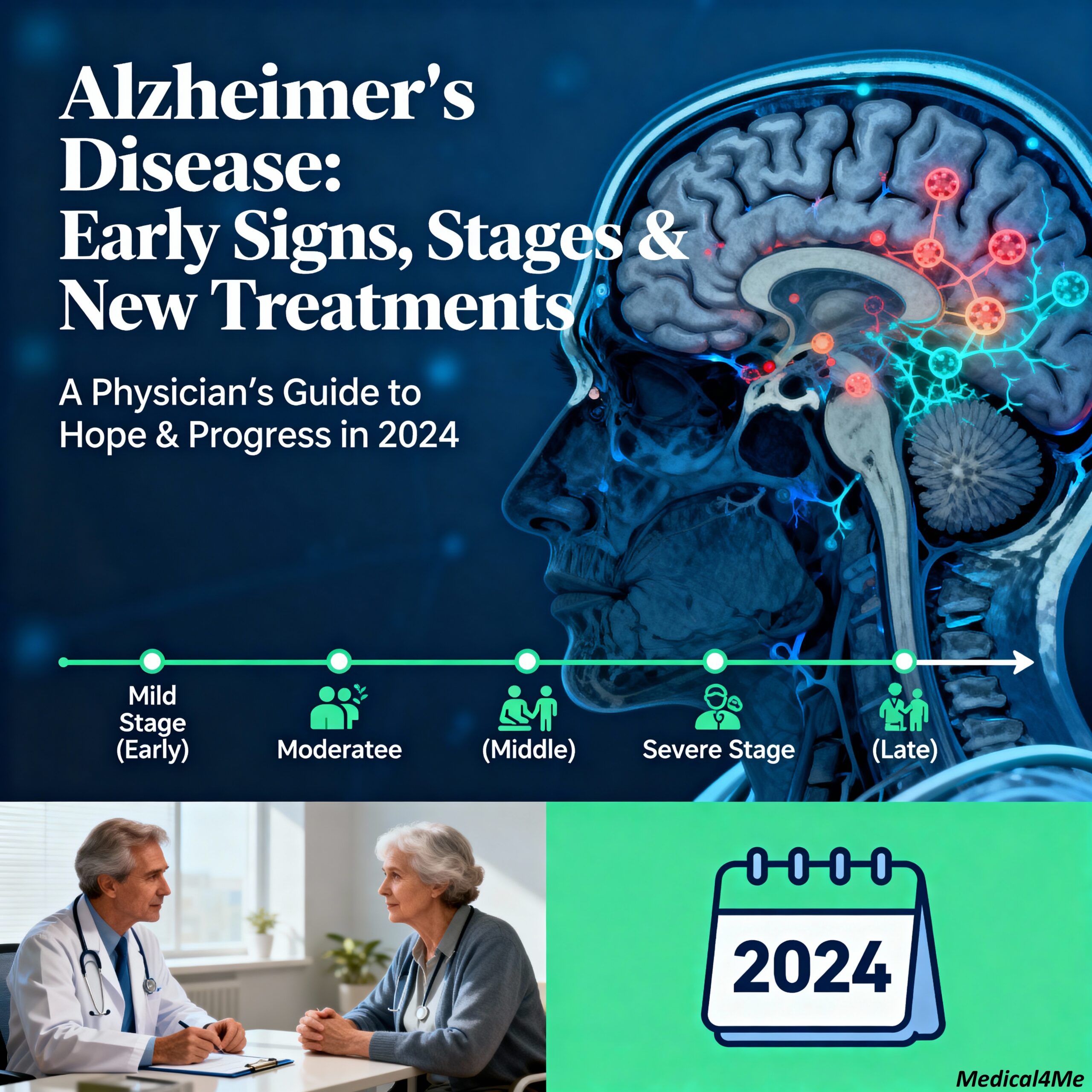Alzheimer’s Disease: A Physician’s Guide to Signs, Stages & Hope
In my practice, I’ve seen the look in a patient’s eyes when they talk about their memory. It’s a mix of fear, confusion, and frustration. They’ll say, “I just can’t remember names anymore,” or “I got lost on a familiar road.” I understand this can be scary. The word Alzheimer’s disease itself is heavy. Hearing it for the first time, whether for yourself or a loved one, is a real gut punch. Many people feel overwhelmed, and they don’t know what to ask.
But here’s what I tell every family: you are not alone, and you’re in the right place to get clear answers. We’re going to walk through this together. This guide is designed to cut through the noise and give you the straightforward information you need about this memory loss condition. We’ll cover what it is, the early signs, and what you can actually do about it. Let’s start.

What Exactly Is Alzheimer’s Disease?
Alzheimer’s Disease Defined
Alzheimer’s disease is a physical disease that attacks the brain. It’s progressive, meaning it gets worse over time, and it’s the number one cause of dementia worldwide. Basically, it causes a slow decline in memory, thinking, and reasoning skills. The culprits are two proteins: amyloid plaques, which are like sticky clumps that build up between nerve cells, and tau tangles, which are twisted fibers that build up inside the cells. These two troublemakers block communication and eventually kill brain cells.
Let me break it down with an analogy I use with my patients. Think of your brain as a super-organized office with a perfect filing system for all your memories and thoughts. Alzheimer’s is like a rogue employee who comes in and starts putting sticky notes (plaques) all over the filing cabinets, making them hard to open. At the same time, they’re tangling up all the phone lines (tau) inside the office. At first, it’s just a minor annoyance. But over time, no one can find anything or talk to each other, and the whole office grinds to a halt. It’s a structural failure.
Recognizing the Symptoms and Signs of Cognitive Decline
The indicators of Alzheimer’s disease don’t just appear overnight. It’s a slow burn. What I’ve learned is that families often notice small changes long before a diagnosis is made. They’ll say, “Mom just isn’t herself.” It’s vital to know what you’re looking for, because early recognition is everything. Let’s look at the progression of these signs.
🟢 Mild Stage (Early)
A person can still function pretty independently here. They might still be driving and managing their own affairs, but they feel like something is “off.”
- Trouble finding the right word. It’s on the tip of their tongue but won’t come out.
- Forgetting the names of new acquaintances almost immediately.
- Losing or misplacing things far more often than before.
- Difficulty with planning or organizing, like following a recipe or managing a budget.
🟡 Moderate Stage (Middle)
This is often the longest stage. The damage to the brain’s cognitive function causes more noticeable problems, and the person needs more support.
- Forgetting major personal history, like their own address or where they went to school.
- Becoming moody or withdrawn, especially in challenging social situations.
- Confusion about the day of the week or where they are. This can be very distressing.
- Changes in sleep. Often sleeping during the day and being restless at night.
🔴 Severe Stage (Late)
In the final stage, personality changes are significant and people need a lot of help with daily care. Communication becomes very difficult. A very tough road for families.
- Requires full-time help with dressing, eating, and using the bathroom.
- Loses awareness of their surroundings and recent experiences.
- Physical abilities decline. They have trouble walking, sitting, and eventually swallowing.
- They’re highly vulnerable to infections, like pneumonia.

Understanding Causes and Risk Factors
Patients always ask me, “Why did this happen?” The reality is, we don’t have one single answer. For the vast majority of people, Alzheimer’s disease seems to be caused by a mix of factors. It’s not your fault. It’s a combination of the genes you’re born with, your environment, and your lifestyle choices over decades. And what I’ve learned is that while you can’t change your genes, you have more control over the other factors than you might think. Let’s look at the main risk factors.
- Age: This is the biggest one. The risk goes up significantly after age 65. The [SOURCE: World Health Organization] notes that age is the strongest known risk factor for cognitive decline.
- Family History and Genetics: Yes, it can run in families. If your parent or sibling has it, your risk is slightly higher. A specific gene, APOE-e4, is a known risk factor but it is not a death sentence. Many people with the gene never get Alzheimer’s.
- Heart Health: This is huge. If it’s bad for your heart, it’s bad for your brain. High blood pressure, high cholesterol, diabetes, and smoking all increase your risk of this neurodegenerative disorder.
- Head Injury: There’s a clear link between a history of serious head trauma and future risk. Wear your seatbelt, and wear a helmet. Simple.
- Social and Cognitive Engagement: A lifetime of learning and social interaction helps build what we call “cognitive reserve.” It’s like building a stronger brain that can better withstand disease-related changes.
The Diagnostic Journey: What to Expect
I’ve walked so many families through this process. It’s a marathon, not a sprint, and the uncertainty can be the hardest part. There’s no single blood test or scan that screams “Alzheimer’s disease.” Instead, as a medical professional, I act like a detective. I gather clues from different sources to rule out other possibilities and arrive at the most likely diagnosis. We can be about 90% accurate this way.
Here’s what the process typically looks like:
- A Detailed Talk: We’ll sit down and talk. About your health, your family’s health history, and the specific changes you’ve noticed in your memory or thinking.
- Cognitive Testing: I’ll use simple tests with pen and paper to check your memory, problem-solving skills, and attention. This gives us a baseline.
- A Physical and Neurological Exam: I’ll check your reflexes, balance, and senses to make sure it’s not something else, like a stroke or Parkinson’s.
- Brain Scans (MRI/CT): These scans let me see the structure of your brain. I’m looking for tumors, evidence of small strokes, or other issues that could cause the symptoms.
- Advanced Tests (PET/CSF): In some cases, we might use a PET scan to see amyloid plaques in the brain, or a spinal tap to test the cerebrospinal fluid for biomarkers. These are becoming more common for a confident early diagnosis.

Treatment Options: A Comparative Look
Here’s the thing about treating Alzheimer’s disease: we attack it from all sides. There’s no magic bullet. A good therapy plan combines medication, lifestyle changes, and strong support for both the patient and the family. And I want to be clear: the options we have today are better than they were just a few years ago. We are now moving from just managing symptoms to actually slowing down the disease itself.
| Treatment Approach | How It Works | Effectiveness & Considerations |
|---|---|---|
| Cholinesterase Inhibitors (e.g., Donepezil) | These drugs boost a chemical messenger in the brain that’s important for memory. Used in early to moderate stages. | They don’t stop the disease, but they can help manage symptoms for a time. Some patients get nausea. |
| Memantine | This medicine works on a different chemical system to help with learning and memory in moderate to severe stages. | It can help reduce symptoms and is often used with a cholinesterase inhibitor. It’s generally well-tolerated. |
| Anti-Amyloid Therapies (e.g., Lecanemab) | These are the new game-changers. They are antibodies given by IV that physically remove amyloid plaques from the brain. | Proven to modestly slow the progression of cognitive decline in early Alzheimer’s dementia. This is a huge deal. But, they require regular infusions and monitoring for side effects. |
| Lifestyle & Support | This includes exercise, a brain-healthy diet, social engagement, and creating a safe, structured routine. | Absolutely essential. This approach has zero side effects and dramatically improves quality of life. In my clinical experience, families who embrace this do much better. |

Brain Health and Prevention Strategies
So, what can you actually *do* to protect your brain? While there’s no guaranteed way to prevent Alzheimer’s disease, research is overwhelmingly clear that you can significantly lower your risk. It’s about being proactive, not passive. The same choices that protect your heart also protect your head. It’s never too late to start making smarter choices for your brain health.
Your Brain Health Action Plan
- Get Moving: Aim for at least 150 minutes of moderate exercise, like brisk walking, per week. It increases blood flow to the brain.
- Eat Smart: Adopt a diet rich in vegetables, berries, nuts, and fish, like the Mediterranean or MIND diet. What you eat matters.
- Stay Sharp: Challenge your mind every day. Read, do puzzles, learn a new skill, or take a class. Force your brain to make new connections.
- Be Social: Don’t isolate yourself. Regularly connecting with friends and family is a powerful protective factor against cognitive decline.
- Control Your Numbers: Work with your doctor to manage your blood pressure, cholesterol, and blood sugar. This is a critical step.
Think of these steps as deposits into your “cognitive reserve” bank account. The more you deposit over your lifetime, the more your brain has to draw upon if disease ever strikes. For more on this, check out the resources on [ brain health on Medical4Me.com].
When to See a Doctor: The Red Flags
Stop Guessing. Make the Call.
One of the biggest mistakes I see is waiting too long. People dismiss serious signs as “just a senior moment.” If memory issues are affecting safety, relationships, or the ability to live independently, it’s time to see a physician. Don’t let fear or denial stop you from getting answers.
I can’t be more direct about this. An early diagnosis of a potential memory loss condition like Alzheimer’s disease is your most powerful tool. It unlocks access to treatments that work best in the early stages and gives you time to plan for the future. Watch for these red flags:
- Memory loss that disrupts daily life. Forgetting recently learned information is a classic sign.
- Poor judgment or decision-making. Things like making bad financial decisions or neglecting personal hygiene.
- Difficulty with familiar tasks at home or work.
- Confusion about time or place. Losing track of the date or getting lost in a familiar neighborhood.
- Withdrawal from social activities and changes in personality.
If this sounds like you or someone you love, your next step is to schedule a doctor’s appointment. The [SOURCE: Mayo Clinic] has an excellent symptom checker you can review before your visit.
A Patient’s Journey: The Story of Robert and His Wife
I remember Robert, a 72-year-old retired engineer, and his wife, Maria. She brought him in because he, a man who built bridges, had started having trouble assembling their new bookshelf. He’d also withdrawn from his weekly coffee with friends. Robert was frustrated and Maria was terrified. The dynamic in their home had shifted from partnership to one of patient and caregiver. It’s a lonely feeling for both.
We went through the diagnostic journey and confirmed early-stage Alzheimer’s disease. But here’s what happened next. We got Robert into a clinical trial for a new medicine. Maria joined a caregiver support group I recommended—a place she could vent, cry, and get practical advice from people who *got it*. They used technology to set up daily reminders for Robert, giving him back some independence. It wasn’t the retirement they planned, but they found a new way to be a team. Their story shows that a diagnosis is not just an ending, it’s a new beginning that requires a new plan.
The Latest Research: A New Era of Hope
Now for the part that genuinely excites me as a physician. For so long, we had little to offer patients beyond managing symptoms. But the last 24 months have completely changed the game for Alzheimer’s disease treatment. We are finally targeting the disease itself. It’s a paradigm shift.
The headline news is the FDA’s full approval of anti-amyloid drugs. Here’s what you need to know:
- Disease-Modifying Drugs: Drugs like Lecanemab (brand name Leqembi) are the first to be definitively shown to slow the progression of this neurodegenerative disorder. A landmark 2023 clinical trial showed it could slow decline by nearly 30% in early-stage patients. This is not a cure. But it’s a weapon we’ve never had before.
- The Blood Test Revolution: For years, a definitive diagnosis required expensive scans or invasive spinal taps. As of 2024, highly accurate blood tests are entering clinical use. These tests can detect Alzheimer’s biomarkers years earlier. According to the [SOURCE: NIH], this will make early diagnosis cheaper, faster, and more accessible to everyone. Faster diagnosis means earlier treatment.
This is what progress looks like. It’s not a single breakthrough, but a series of powerful new tools that are changing the future for patients. And if you’re interested in being a part of this progress, you can learn more about clinical trials for dementia on Medical4Me.com.
Frequently Asked Questions
Well, that’s a common point of confusion. Think of it this way: ‘Dementia’ is the umbrella term for a set of symptoms like memory loss and confusion. Alzheimer’s disease is the most common specific disease that *causes* those symptoms. So, while all people with Alzheimer’s have dementia, not everyone with dementia has Alzheimer’s.
Right now, we don’t have a cure that can stop or reverse it completely. But, and this is a big but, we now have FDA-approved medications that are proven to modestly slow down the progression of the disease in its early stages. This is a huge leap forward. It’s about buying more quality time, not a full stop.
Having a parent or sibling with Alzheimer’s does increase your risk slightly, but it’s far from a guarantee. Honestly, the vast majority of cases are ‘sporadic,’ meaning they don’t have a direct, single genetic link. Your lifestyle choices—diet, exercise, and staying mentally active—play a massive role in influencing your personal risk.
This is tough. I suggest approaching it with compassion and concern, not accusation. Use ‘I’ statements, like, ‘I’ve been worried about you lately, and I’d feel better if we could just get a check-up together.’ Focus on a specific symptom, like managing medications or bills, rather than just ‘your memory.’ And choose a calm, quiet time to talk.
Probably not! We all misplace things. The key difference is the pattern and impact on your life. Forgetting where you parked your car is one thing. Forgetting how to get to the grocery store you’ve been going to for 20 years is another. Normal aging involves occasional slip-ups. Alzheimer’s involves memory and cognitive changes that consistently disrupt your daily life.
Where Do You Go From Here? A Final Word of Hope
We’ve covered a lot of ground on Alzheimer’s disease. If you’re feeling a little overwhelmed, take a deep breath. The single most important takeaway is this: there is hope, and there is help. The science is moving faster than ever, and our approach to care is more compassionate and effective than it has ever been. You don’t have to navigate this cognitive decline in the dark.
- You know the warning signs to look for.
- You understand that an early diagnosis is a tool, not a sentence.
- You know that new treatments and proactive lifestyle choices can make a real difference.
Your journey starts with a single step. Start a conversation with your family. Schedule an appointment with a doctor. Reach out for support. You have the power to face this challenge with clarity, courage, and a solid plan. You can do this.
Learn the Red Flag Symptoms
💬 Share Your Experience
Share your thoughts, questions, or personal tips below. Our community and editorial team value respectful and insightful discussions.